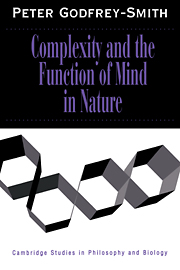8 - The signal detection model
Published online by Cambridge University Press: 05 June 2012
Summary
The next question
The previous chapter looked at some relationships between flexible and inflexible ways of dealing with environments while assuming that the cue used in a flexible strategy is a “given,” a fixed constraint within which the organism optimizes. The organism either makes use of this cue, accepting its reliability properties, or it does not. It was also assumed that there are no additional intrinsic costs associated with being flexible. The only costs discussed in Chapter 7 are costs stemming from making wrong decisions. In this chapter both of these assumptions will be dropped. We will look at ways in which organisms can shape the reliability properties of cues they use, and we will also look at one way to build in some costs associated with the mechanisms that make flexibility possible. The same modifications to the model of the previous chapter will address both of these issues at once. In the previous chapter we assumed that a cue with certain reliability properties was available, and asked: should the organism use this cue in the determination of behavior? In this chapter the question is: given the general nature of an organism's physical connections to the world, what is the best cue available for guiding its behavior with respect to a particular problem?
These questions will be addressed with the aid of signal detection theory, a psychologistic application of statistical decision theory.
- Type
- Chapter
- Information
- Complexity and the Function of Mind in Nature , pp. 232 - 254Publisher: Cambridge University PressPrint publication year: 1996



